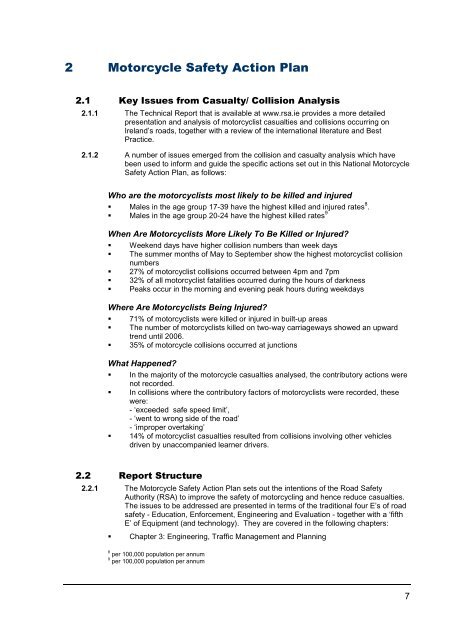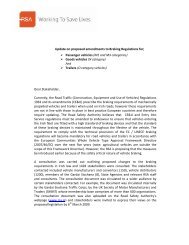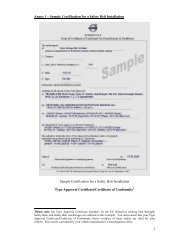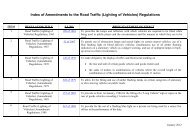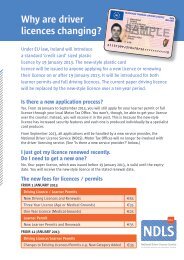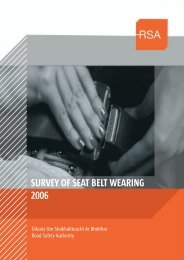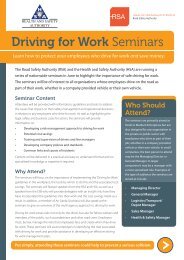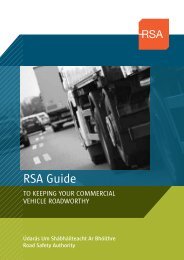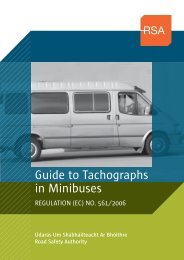National Motorcycle safety action plan - Road Safety Authority
National Motorcycle safety action plan - Road Safety Authority
National Motorcycle safety action plan - Road Safety Authority
You also want an ePaper? Increase the reach of your titles
YUMPU automatically turns print PDFs into web optimized ePapers that Google loves.
2 <strong>Motorcycle</strong> <strong>Safety</strong> Action Plan<br />
2.1 Key Issues from Casualty/ Collision Analysis<br />
2.1.1 The Technical Report that is available at www.rsa.ie provides a more detailed<br />
presentation and analysis of motorcyclist casualties and collisions occurring on<br />
Ireland’s roads, together with a review of the international literature and Best<br />
Practice.<br />
2.1.2 A number of issues emerged from the collision and casualty analysis which have<br />
been used to inform and guide the specific <strong>action</strong>s set out in this <strong>National</strong> <strong>Motorcycle</strong><br />
<strong>Safety</strong> Action Plan, as follows:<br />
Who are the motorcyclists most likely to be killed and injured<br />
• Males in the age group 17-39 have the highest killed and injured rates 8 .<br />
• Males in the age group 20-24 have the highest killed rates 9<br />
When Are Motorcyclists More Likely To Be Killed or Injured?<br />
• Weekend days have higher collision numbers than week days<br />
• The summer months of May to September show the highest motorcyclist collision<br />
numbers<br />
• 27% of motorcyclist collisions occurred between 4pm and 7pm<br />
• 32% of all motorcyclist fatalities occurred during the hours of darkness<br />
• Peaks occur in the morning and evening peak hours during weekdays<br />
Where Are Motorcyclists Being Injured?<br />
• 71% of motorcyclists were killed or injured in built-up areas<br />
• The number of motorcyclists killed on two-way carriageways showed an upward<br />
trend until 2006.<br />
• 35% of motorcycle collisions occurred at junctions<br />
What Happened?<br />
• In the majority of the motorcycle casualties analysed, the contributory <strong>action</strong>s were<br />
not recorded.<br />
• In collisions where the contributory factors of motorcyclists were recorded, these<br />
were:<br />
- ‘exceeded safe speed limit’,<br />
- ‘went to wrong side of the road’<br />
- ‘improper overtaking’<br />
• 14% of motorcyclist casualties resulted from collisions involving other vehicles<br />
driven by unaccompanied learner drivers.<br />
2.2 Report Structure<br />
2.2.1 The <strong>Motorcycle</strong> <strong>Safety</strong> Action Plan sets out the intentions of the <strong>Road</strong> <strong>Safety</strong><br />
<strong>Authority</strong> (RSA) to improve the <strong>safety</strong> of motorcycling and hence reduce casualties.<br />
The issues to be addressed are presented in terms of the traditional four E’s of road<br />
<strong>safety</strong> - Education, Enforcement, Engineering and Evaluation - together with a ‘fifth<br />
E’ of Equipment (and technology). They are covered in the following chapters:<br />
• Chapter 3: Engineering, Traffic Management and Planning<br />
8 per 100,000 population per annum<br />
9 per 100,000 population per annum<br />
7


